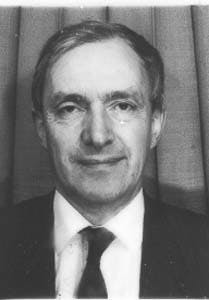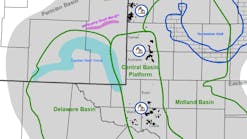Peter J. H. Carnell
ICI Katalco
Billingham, U.K.Ken W. Joslin
Mobil Research &
Development Corp.
DallasPeter R. Woodham
Mobil North Sea Ltd.
St. Fergus, U.K.
Mobil North Sea Ltd.'s Scottish Area Gas Evacuation (SAGE) plant at St. Fergus, Scotland, has been designed to process a broad range of contract gases. It is currently the only U.K. terminal capable of processing northern North Sea sour associated gas containing both H2S and CO2- A key element has been integration of fixed-bed processes for selective removal of COS and H2S from the gas and liquid product streams. The result has been operating flexibility and significant capital savings.
SAGE system partners are Amerada Hess Ltd., Bow Valley Petroleum (UK) Ltd., British Borneo Oil & Gas Ltd., British Gas Exploration & Production Ltd., British Gas North Sea Holdings Ltd., British Petroleum Exploration Operating Co. Ltd., Enterprise Oil Plc., Kerr-McGee Oil (UK) Plc., LL&E (UK) Inc., Marathon Oil UK Ltd., Mobil North Sea Ltd., OMV (UK) Ltd., and Sovereign Oil & Gas Plc. (OGJ, Mar. 8,1993, p. 37).
Mobil North Sea operates the pipeline system and gas terminal at St. Fergus and processes gas from three North Sea producing fields: Beryl, operated by Mobil North Sea; Scott, operated by Amerada Hess; and Brae, operated by Marathon Oil (Fig. 1)(44105 bytes).
TWO PHASES
The terminal can process 1,150 MMscfd of sour gas, with the sales gas being delivered into British Gas' distribution network and NGLs exported by pipelines to Shell and BP.
The terminal consists of two gas-processing trains that were completed in two phases.
The first train, with capacity for processing 500 MMscfd of sweet gas from Beryl, was brought on-line in July 1992. Gas export from Scott was added to this train in November 1993.
The second phase, completed in March 1994, allowed sour gas from Brae to be treated, beginning July 1994. The overall capital cost of the SAGE terminal development was $600 million.
The three producing fields have very different compositions. Scott produces primarily oil (up to 200,000 b/d) with approximately 120 MMscfd of a rich sour associated gas.
Beryl can produce around 410 MMscfd of a medium-rich sweet gas, and Brae can produce up to 575 MMscfd of a lean sour gas.
These three different gases are delivered to the terminal at 120-170 barg in a dense-phase pipeline. Addition of the second train and sweetening facilities brings the terminals capacities up to 1,150 MMscfd (32.6 million cu m/d) of feed gas and 60,000 b/d (5,500 metric tons/day; mtd) of NGL.
The sales-gas product is exported into British Gas' distribution network and the associated NGL product is either pumped to the Shell NGL fractionation plant at Mossmorran via the Shell terminal at St. Fergus or to the BP fractionation plant at Kinneil.
The SAGE terminal is the first of a new generation designed to deal with a complex operating regime. It must meet tight sales specifications while processing mixtures of the three different feed gases being produced from three independent fields.
Table 1 (11803 bytes) gives the range of feed gas compositions considered the gas plant's design.
That design, which relied on regenerable liquid absorbents for the main purification duties and on nonregenerable absorbents for final control of sulfur compounds, yielded the required operating flexibility at a reasonable capital cost.
Fig. 2 (37521 bytes) shows a simplified flow for the processing plant with the two separate construction phases illustrated. Using the pressure available from the pipeline to obtain gas/liquid separation via turboexpanders produces the following for the plant:
- Dehydration by molecular sieves is required prior to the turboexpanders. to prevent hydrate or ice formation.
- The sales gas and NGL products are individually treated. The absence of commercially proven technology to treat dense-phase feed gas directly made this necessary.
- Glycol dehydration is required after the acid-gas removal units to make the sales-gas H2O specification.
SOUR-GAS DRYING
The feed gases are dehydrated offshore down to 3 lb/MMscf before export to avoid hydrate formation in the subsea pipeline and for its protection.
Hydrate or ice formation in the St. Fergus NGL separation plant is avoided by further dehydration of the gases with molecular sieves down to 1 ppm (Vol; ppmv). Because the raw gas contains CO2 and H2S, UOP'S COS minimizing molecular sieves (Cosmin 105A) are used to control COS formation.
Because the regeneration gas on the SAGE plant is recirculated to the feed stream for reprocessing (there being insufficient fuel-gas demand there to allow burning the regeneration gas as fuel), a potential problem remains due to spikes of COS and H2S released from the sieves during regeneration.
These spikes tend to concentrate in the liquids from the turboexpanders and, with no back-mixing or intermediate storage for the NGL, this would require the sales gas and NGL treaters (discussed later) to be designed for these peak COS and H2S concentrations.
To avoid this problem, the SAGE design removes these spikes using beds of ICI Katalco's Puraspec absorbent in the molecular-sieve regeneration system. Fig. 3 (35650 bytes) shows this arrangement.
Each bed has a catalyst for COS hydrolysis on top of a bed of H2S absorbent. The molecular-sieve regeneration program, as recommended by UOP, uses a temperature and flow profile designed to attenuate the height of the H2S and COS peaks and release the sulfur compounds from the sieves before bulk desorption of water commences.
This ensures that the absorbent beds are always operated above the water dew point, avoiding the risk of condensation.
These units have been operated through many regeneration cycles with no mechanical damage and with H2S and COS slip of
The increased temperature promotes migration of sulfur ions into the absorbent lattice and consequently the exposure of fresh active sites.
NGL PURIFICATION
Despite the use of UOP's COS minimizing molecular sieves, with certain feed-gas mixes and plant operating conditions, the NGL product will contain small amounts of H2S and COS.
This is essentially due to the concentrating effect mentioned earlier as the feed gas is separated into gas and liquid. Table 2 (11632 bytes) gives typical NGL compositions used for the design of these facilities.
There are two different NGL export routes which have slightly different contractual conditions regarding trace sulfur compounds.
Both contracts require low residual levels of sulfur compounds (H2S/COS) to be left in the NGL. Because of the different downstream processing involved, however, one export route requires essentially all the COS to be removed. The other route is more concerned with H2S removal.
The NGLs are completely dry. And, although H2S removal with Puraspec absorbents presented no problem, there was a concern that COS removal would be difficult.
To prove that the desired COS removal was possible, a pilot plant was constructed and the proposed design mimicked by use of undecane spiked with COS.
This work produced some interesting data. Trials were carried out at various levels of COS up to 100 ppm with a water content of
It was found that, even with this level of dryness, at 80-1200 C., both H2S and COS were removed to the level of detection, i.e.,
Fortunately, the fractionation unit always operates at greater than 800 C. Therefore, there is no problem in ensuring the complete removal of COS (Table 2).
GAS SWEETENING
The SAGE system provides the only current facility able to process a sour gas containing both CO2 and H2S from the Northern North Sea. The plant design basis allows for the handling of feed gases up to 11 mole % CO2 and 20 ppm mol H2S.
Before export to the British Gas terminal, the dry gas from the gas-liquid separation process passes through an amine absorber which simultaneously removes CO2 and H2S.
At St. Fergus, a proprietary amine process based on methyl diethanolamine (MDEA), licensed by BASF, is used.
Pure MDEA is often used for H2S removal, but the formulation of the amine solvent used at St. Fergus includes an "activator" to accelerate CO2-amine reactions, making the amine solvent practical for simultaneous H2S and CO2 removal.
The licensed process is usually known as the BASF Activated MDEA process, or aMDEA.
It is important not to remove all the CO2 from the SAGE sales gas. Some CO2 must be removed to bring the sales gas within British Gas' specifications. If too much is removed, however, sales-gas quality becomes limited by calorific value or Wobbe index.
At St. Fergus, the process is optimized when the sales-gas CO2 content is near British Gas' maximum of 4 mole %. The CO2 content of sales gas being exported to British Gas is controlled by either bypassing some of the gas around the aMDEA absorber or adjusting the aMDEA process to slip the required CO2 from the absorber overheads.
The first method of controlling sales gas CO2 is used at high plant throughputs. Since the aMDEA absorber can remove all CO2 from its feed gas, it has only been sized to handle the flow which, when recombined with the gas bypassing the absorber, yields the required sales-gas CO2 content.
If sales-gas CO2 has been controlled in this way, the portion of gas bypassing the aMDEA absorber may still render the sales gas "offspec" with respect to H2S.
Vessels containing solid nonregenerable ICI Puraspec absorbent beds are therefore provided to polish residual traces of H2S from the gas before export to British Gas.
Whenever the gas export rate is less than the capacity of the absorber, all gas is allowed to pass through the absorber to remove all the H2S with aMDEA, saving expenditure on absorbent.
This can be done because the BASF process has been adapted for the SAGE plant to allow all H2S to be removed from a gas while leaving CO2 in the absorber column's overheads. This has been made possible by optimizing the process' activator concentration and providing multiple solvent injection points on the aMDEA absorber.
A simplified process flowsheet is given in Fig. 4.(25307 bytes)
The criteria for setting the activator concentration were twofold:
- It must be high enough to remove all CO2 and H2S at high absorber gas rates and feed CO2 concentrations, without resorting to an unduly tall absorber column.
- It must be low enough so that, at low absorber gas-feed rates with a low CO2 content, all H2S can be removed while the desired level of CO2 remains in the absorber overheads.
The multiple aMDEA solvent-injection points provide flexibility to remove all H2S at any feed and CO2 concentration. At low feed CO2 concentrations, high solvent-circulation rates are necessary to remove all the H2S.
To avoid removing more CO2 than desired, however, a low absorber solvent injection point is used effectively to reduce the absorber's available packing height.
The SAGE gas-processing plant has now processed some 350 bscf of feed gas and produced 20 million bbl of NGLs. All of the design combinations of gas have been handled with few processing problems.
The high flexibility of the design means that the plant can be used in the future to process different combinations of gases.


